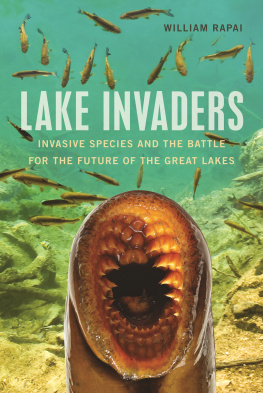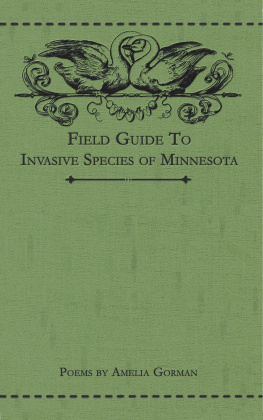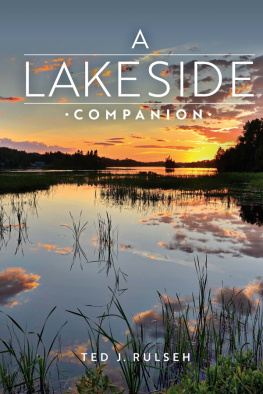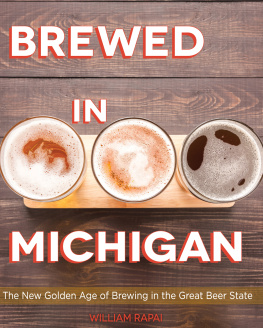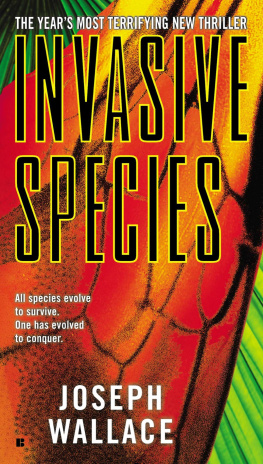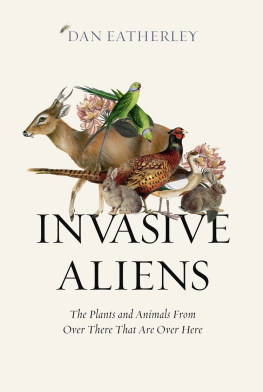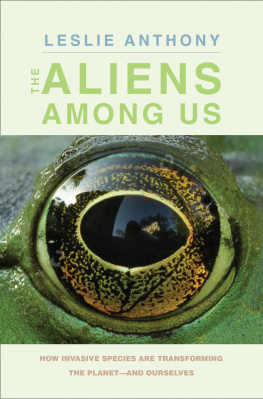William Rapai - Lake invaders : invasive species and the battle for the future of the great lakes
Here you can read online William Rapai - Lake invaders : invasive species and the battle for the future of the great lakes full text of the book (entire story) in english for free. Download pdf and epub, get meaning, cover and reviews about this ebook. year: 2016, genre: Art. Description of the work, (preface) as well as reviews are available. Best literature library LitArk.com created for fans of good reading and offers a wide selection of genres:
Romance novel
Science fiction
Adventure
Detective
Science
History
Home and family
Prose
Art
Politics
Computer
Non-fiction
Religion
Business
Children
Humor
Choose a favorite category and find really read worthwhile books. Enjoy immersion in the world of imagination, feel the emotions of the characters or learn something new for yourself, make an fascinating discovery.
- Book:Lake invaders : invasive species and the battle for the future of the great lakes
- Author:
- Genre:
- Year:2016
- Rating:5 / 5
- Favourites:Add to favourites
- Your mark:
- 100
- 1
- 2
- 3
- 4
- 5
Lake invaders : invasive species and the battle for the future of the great lakes: summary, description and annotation
We offer to read an annotation, description, summary or preface (depends on what the author of the book "Lake invaders : invasive species and the battle for the future of the great lakes" wrote himself). If you haven't found the necessary information about the book — write in the comments, we will try to find it.
William Rapai: author's other books
Who wrote Lake invaders : invasive species and the battle for the future of the great lakes? Find out the surname, the name of the author of the book and a list of all author's works by series.
Lake invaders : invasive species and the battle for the future of the great lakes — read online for free the complete book (whole text) full work
Below is the text of the book, divided by pages. System saving the place of the last page read, allows you to conveniently read the book "Lake invaders : invasive species and the battle for the future of the great lakes" online for free, without having to search again every time where you left off. Put a bookmark, and you can go to the page where you finished reading at any time.
Font size:
Interval:
Bookmark:

GREAT LAKES BOOKS
EDITOR
Thomas Klug, Marygrove College
ADVISORY EDITORS
Fredric C. Bohm, DeWitt, Michigan
Sandra Sageser Clark, Michigan Historical Center
Thomas R. Dilley, Grand Rapids, Michigan
Brian Leigh Dunnigan, Clements Library
De Witt Dykes, Oakland University
Joe Grimm, Michigan State University
Laurie Harris, Pleasant Ridge, Michigan
Charles K. Hyde, Pittsfield, Massachusetts
Susan Higman Larsen, Detroit Institute of Arts
Philip P. Mason, Prescott, Arizona and Eagle Harbor, Michigan
Dennis Moore, Consulate General of Canada
Erik C. Nordberg, Walter P. Reuther Library
Deborah Smith Pollard, University of MichiganDearborn
Michael O. Smith, Bentley Historical Library
Arthur M. Woodford, Harsens Island, Michigan
A complete listing of the books in this series can be found online at wsupress.wayne.edu
LAKE INVADERS
INVASIVE SPECIES AND THE BATTLE FOR THE FUTURE OF THE GREAT LAKES
WILLIAM RAPAI

2016 by Wayne State University Press, Detroit, Michigan 48201. All rights reserved. No part of this book may be reproduced without formal permission. Manufactured in the United States of America.
20 19 18 17 16 5 4 3 2 1
ISBN 978-0-8143-4124-7 (paperback)
ISBN 978-0-8143-4125-4 (ebook)
Library of Congress Cataloging Number: 2015958674

Designed and typeset by Bryce Schimanski
Composed in Adobe Caslon Pro
To my father, the old fisherman
He may be gone, but fish still tremble at his name
CONTENTS
ACKNOWLEDGMENTS
The best thing about a project like this is the ability to meet interesting people who are doing cool things. In the course of writing this book, Ive interviewed more than a hundred people from the United States and Canada, and I can honestly say I have not met one that I didnt like.
It would be impossible for me to list all the people and thank them individually, so let me just issue a blanket statement: Thank you all. I appreciate everything youve done for me. I appreciate your guidance, your answers, your thoughts, your frankness, your effort, and your time.
Nevertheless, I must thank a few people in particular for their special contributions:
Erika Jensen for your patience and competence, and for never running away when you saw me coming.
Sarah LeSage and David Reid for keeping me from drowning in ballast water.
Mike Hoff for your dedication, insight, and good humor.
Lindsay Chadderton for answering my dumb questions with a smile and not a smirk.
And finally to David Jude for reminding me that theres still wonder in the world around me, and its okay to get excited about it.
The biggest thank-yous go to my family. To Maggie and Julia, thank you for keeping me on my toes, for being patient, for helping me to keep perspective, and for not losing faith in your old dad. Of course, the biggest thank-you of all goes to The Lovely Joann. I appreciate you looking over my shoulder, keeping me on track, and giving me inspiration every day. Instead of forcing me to take a soul-crushing job in a windowless cubicle, you have allowed me to go off on two quixotic journeys that, well, havent provided much help when it comes to paying the bills. But for giving me the freedom to explore and follow my curiosity, I shall always be grateful.
INTRODUCTION
Lurking in the murky brown-gray water of an Illinois river, just fifty-five miles from Lake Michigan, is a swarm of creatures so scary, so disgusting, that many people want them exterminated.
Theyre slimy and ugly. They jump at the approach of humans, and if one hits you, it could break your nose. They breed like crazy, capable of producing millions and millions of offspring in a single year. Once you have them, you cant get rid of them; despite their huge population, they are hard to find and hard to catch. And theyre hungry. They are so hungry in fact that theyre stripping rivers clean of food, and biologists fear what these hungry beasts could do if they were to reach the Great Lakes.
While these carpsthese vandals at the gatesreceive massive attention, other invasive species have been attacking, doing massive damage to the Great Lakes for seventy years, often without notice. More than 180 exotic species are in the Great Lakes. Some, such as green algae, the Asian tapeworm, and the suckermouth minnow, have had little or no impact so far. But a handful of otherssea lamprey, alewife, round goby, quagga mussel, zebra mussel, Eurasian watermilfoil, spiny water flea, and rusty crayfishhave conducted an all-out assault on the Great Lakes and are winning the battle. In the process, they have changed the populations of native fish and planktons. Theyve changed water clarity and water chemistry. Theyve changed the food web and the nutrient cycle.
The carps? In reality, if they were to enter the Great Lakes, they would only be shooting the wounded.
Of course, we humans are not aquatic animals, so the changes occurring as a result of these introductions are not something we can easily see. But if we lived under the surface of the water, we would be shocked by what we see today: strange and foreign creatures now have prominent positions in the Great Lakes ecosystem, including a fish with a hundred teeth arranged in a terrifying whorl and a tiny crustacean with a barbed sword for a tail.
For centuries, the Great Lakes were safe from these outsiders. The flow of water from Lake Ontario down the St. Lawrence River to the ocean kept floating organisms from entering. Any fish that was able to fight its way into Lake Ontario could not pass the impenetrable wall of Niagara Falls. But the lakes natural protection was compromised in the eighteenth century with the opening of the Welland Canal, a waterway in southern Ontario that gave aquatic speciesas well as vesselsa path around the falls. Then, in 1959, rapids on the St. Lawrence River were bypassed with the opening of a system of locks that gave foreign organisms access to the farthest reaches of the Great Lakes.
Many of those organisms entered the Great Lakes in the ballast tanks of international shipsfreighters that might as well have been floating aquariums, transporting organisms from Europe, South America, or Asia along with their cargoes. As those ships traveled through the Great Lakes and stopped in ports, they discharged the water that they had taken in elsewherewater that helped the ships stay balanced as they crossed oceans. Animals, bacteria, and viruses from all over the world, welcome to your new home.

Not all the species that have been introduced to the Great Lakes are invasive. In fact, most of the new species in the lakes arent considered invasive because they have not had visible or measurable impacts on the ecosystem. An organism is considered to be exotic if it somehow finds its way into an area beyond its native range or region. Although there are no hard and fast rules, three things can happen to exotics when they enter a new environment.
They can die out because they cannot adapt to the climate and conditions or have no way to reproduce. Perhaps the organisms need salt or brackish water. Perhaps there are predators that will eliminate them before they can become established. Perhaps they cant survive the frigid temperatures of winter or the relatively cold water of a temperate climate. In fact, very few introduced species will survive in the Great Lakes.
Next pageFont size:
Interval:
Bookmark:
Similar books «Lake invaders : invasive species and the battle for the future of the great lakes»
Look at similar books to Lake invaders : invasive species and the battle for the future of the great lakes. We have selected literature similar in name and meaning in the hope of providing readers with more options to find new, interesting, not yet read works.
Discussion, reviews of the book Lake invaders : invasive species and the battle for the future of the great lakes and just readers' own opinions. Leave your comments, write what you think about the work, its meaning or the main characters. Specify what exactly you liked and what you didn't like, and why you think so.

